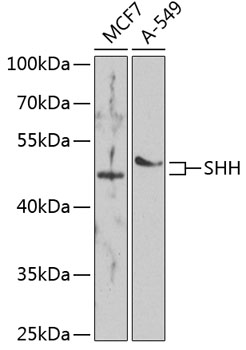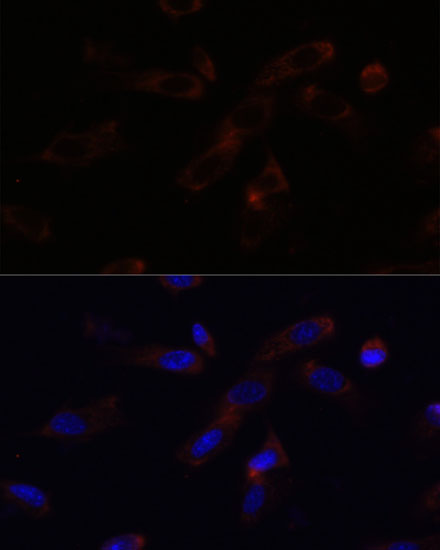Product Detail
Product NameSHH Rabbit Polyclonal Antibody
Host SpeciesRabbit
ClonalityPolyclonal
IsotypeIgG
PurificationAffinity purification
ApplicationsWB,IHC,IF
Species ReactivityHuman,Mouse,Rat
Immunogen DescA synthetic peptide of human SHH
ConjugateUnconjugated
Other NamesSHH;HHG1;HLP3;HPE3;MCOPCB5;SMMCI;TPT;TPTPS
Accession NoSwiss Prot:Q15465
GeneID:6469
Uniprot
Q15465
Calculated MW49kDa
Sdspage MW50kDa
FormulationBuffer: PBS with 0.02% sodium azide,50% glycerol,pH7.3.
StorageStore at -20˚C. Avoid freeze / thaw cycles.
Application Details
WB 1:500 - 1:2000
IHC 1:50 - 1:100
IF 1:50 - 1:200
Immunohistochemistry of paraffin-embedded rat kidney using SHH at dilution of 1:100 (40x lens).
Immunohistochemistry of paraffin-embedded rat lung using SHH at dilution of 1:100 (40x lens).
Western blot analysis of extracts of various cell lines, using SHH at 1:1000 dilution._Secondary antibody: HRP Goat Anti-Rabbit IgG (H+L) at 1:10000 dilution._Lysates/proteins: 25ug per lane._Blocking buffer: 3% nonfat dry milk in TBST._Detection: ECL Enhanced Kit (RM00021)._Exposure time: 60s.
Immunofluorescence analysis of HeLa cells using SHH Polyclonal at dilution of 1:100 (40x lens). Blue: DAPI for nuclear staining.
Immunofluorescence analysis of NIH-3T3 cells using SHH Polyclonal at dilution of 1:100 (40x lens). Blue: DAPI for nuclear staining.
This gene encodes a protein that is instrumental in patterning the early embryo. It has been implicated as the key inductive signal in patterning of the ventral neural tube, the anterior-posterior limb axis, and the ventral somites. Of three human proteins showing sequence and functional similarity to the sonic hedgehog protein of Drosophila, this protein is the most similar. The protein is made as a precursor that is autocatalytically cleaved; the N-terminal portion is soluble and contains the signalling activity while the C-terminal portion is involved in precursor processing. More importantly, the C-terminal product covalently attaches a cholesterol moiety to the N-terminal product, restricting the N-terminal product to the cell surface and preventing it from freely diffusing throughout the developing embryo. Defects in this protein or in its signalling pathway are a cause of holoprosencephaly (HPE), a disorder in which the developing forebrain fails to correctly separate into right and left hemispheres. HPE is manifested by facial deformities. It is also thought that mutations in this gene or in its signalling pathway may be responsible for VACTERL syndrome, which is characterized by vertebral defects, anal atresia, tracheoesophageal fistula with esophageal atresia, radial and renal dysplasia, cardiac anomalies, and limb abnormalities. Additionally, mutations in a long range enhancer located approximately 1 megabase upstream of this gene disrupt limb patterning and can result in preaxial polydactyly.
If you have published an article using product 55301, please notify us so that we can cite your literature.







 Yes
Yes



